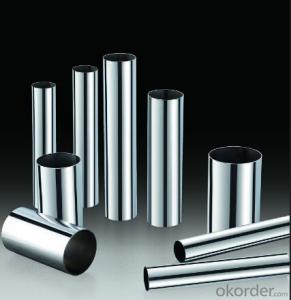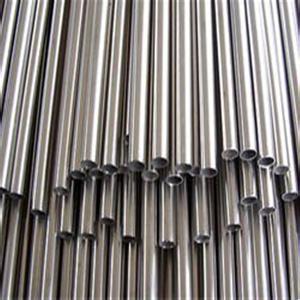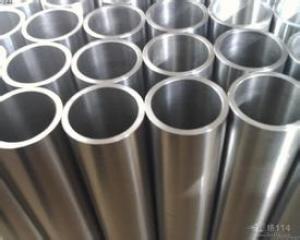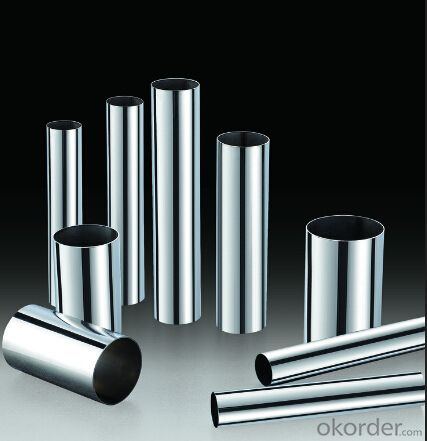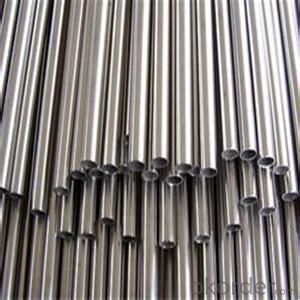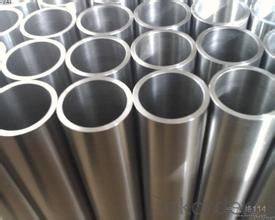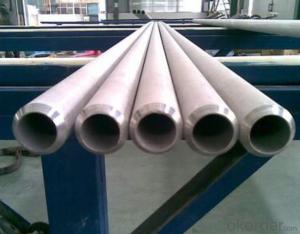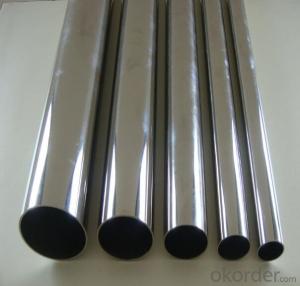Stainless Seamless Steel Pipes With High Quality
- Loading Port:
- China main port
- Payment Terms:
- TT or LC
- Min Order Qty:
- 100 m.t.
- Supply Capability:
- 10000 m.t./month
OKorder Service Pledge
OKorder Financial Service
You Might Also Like
1、Structure of Seamless Pipe :
Seamless pipe is formed by drawing a solid billet over a piercing rod to create the hollow shell and it is regarded as withstanding pressure better than other types, and was often more easily available than welded pipe.
2、Main Features of the Seamless Pipe :
• High manufacturing accuracy
• High strength
• Good visual effect
• Reasonable price
3、Seamless Pipe Specification:
Standard | GB, DIN, ASTM ASTM A106-2006, ASTM A53-2007 |
Grade | 10#-45#, 16Mn 10#, 20#, 45#, 16Mn |
Thickness | 8 - 33 mm |
Section Shape | Round |
Outer Diameter | 133 - 219 mm |
Place of Origin | Shandong, China (Mainland) |
Secondary Or Not | Non-secondary |
Application | Hydraulic Pipe |
Technique | Cold Drawn |
Certification | API |
Surface Treatment | factory state or painted black |
Special Pipe | API Pipe |
Alloy Or Not | Non-alloy |
Length | 5-12M |
Outer Diameter | 21.3-610mm |
Grade | 20#, 45#, Q345, API J55, API K55, API L80, API N80, API P110, A53B |
Standard | ASME, ASTM |
4、Packaging & Delivery of Seamless Pipe
Packaging Details: | seaworthy package,bundles wrapped with strong steel strip |
Delivery Detail: | 15-30days after received 30%TT |
5、FAQ of Seamless Pipe:
①How is the quality of your products?
Our products are manufactured strictly according to national and internaional standard, and we take a test on every pipe before delivered out. If you want see our quality certifications and all kinds of testing report, please just ask us for it.
Guaranteed: If products’ quality don’t accord to discription as we give or the promise before you place order, we promise 100% refund.
②How about price?
We quote as lowest as possible for any customer, and discount can be given according to quantity”,if you like bargain and factory price is not low enough as you think, just don’t waste your time.Please trust the quotation we would give you, it is professional one.
③Why should you chose us?
Our service formula: good quality+good price+good service=customer’s trust
SGS test is available, customer inspection before shipping is welcome, third party inspection is no problem.
Any question, pls feel free to contact us !
6、Seamless Pipe ASTM A106/53 Images:
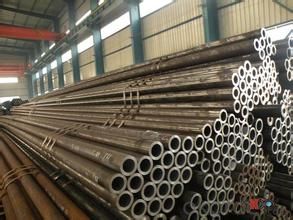
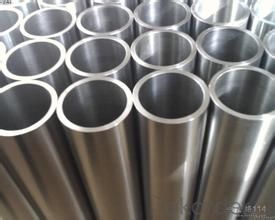
- Q: Can stainless steel pipes be insulated with asbestos?
- No, stainless steel pipes should not be insulated with asbestos. Asbestos is a hazardous material that has been linked to serious health risks, including lung cancer and mesothelioma. It is widely recognized that exposure to asbestos fibers can be extremely dangerous, and its use has been banned in many countries. There are several alternative insulation materials available that are safer and more effective than asbestos. These include fiberglass, mineral wool, and foam insulation. These materials provide excellent thermal insulation properties without posing the same health risks as asbestos. When insulating stainless steel pipes, it is important to consider the specific requirements of the application and choose an appropriate insulation material that meets the necessary safety standards. It is always advisable to consult with a professional insulation contractor or engineer to ensure the correct insulation material is selected.
- Q: Are stainless steel pipes suitable for irrigation systems?
- Yes, stainless steel pipes are highly suitable for irrigation systems. They are corrosion-resistant, durable, and can withstand harsh environmental conditions. Additionally, they offer excellent flow rates, ensuring efficient water distribution in irrigation systems.
- Q: What is stainless steel decorative tube? What uses does it have?
- Stainless steel decorative tubes, decorative stainless steel tubes, made of stainless steel anti-theft windows, stainless steel railings, stainless steel staircase handrails, interior modeling, etc.
- Q: What is the maximum allowable working pressure for stainless steel pipes?
- The maximum allowable working pressure for stainless steel pipes depends on several factors, including the grade of stainless steel, the pipe size, and the temperature at which the pipe will be operating. Generally, stainless steel pipes have higher pressure ratings compared to other materials due to their excellent corrosion resistance. The maximum allowable working pressure (MAWP) is typically determined by standards and codes such as the American Society of Mechanical Engineers (ASME) B31.3 and B31.1 codes. These codes provide guidelines for the design, fabrication, and installation of piping systems. For example, ASME B31.3 provides tables and formulas to calculate the maximum allowable working pressure based on the temperature, wall thickness, and material properties of the stainless steel pipe. The code also considers factors such as safety factors, corrosion allowances, and the intended service conditions. It is important to consult the specific standards and codes applicable to the stainless steel pipe being used to determine its maximum allowable working pressure. Working pressures can vary significantly depending on the pipe grade, dimensions, and intended application.
- Q: Can stainless steel pipes be insulated with polyethylene?
- Yes, stainless steel pipes can be insulated with polyethylene. Polyethylene is a commonly used insulation material for pipes due to its excellent thermal properties and high resistance to moisture. It provides effective insulation to prevent heat loss or gain from the pipe, which is important for applications that require temperature control. Additionally, polyethylene is lightweight, flexible, and easy to install, making it a suitable choice for insulating stainless steel pipes. However, it is essential to ensure that the polyethylene insulation is compatible with the specific type of stainless steel being used to avoid any potential chemical reactions or corrosion.
- Q: What is the tensile strength of stainless steel pipes?
- The tensile strength of stainless steel pipes can vary depending on the specific grade and composition of the steel. However, stainless steel is known for its high tensile strength, making it a popular choice for various applications that require strong and durable pipes. On average, stainless steel pipes have a tensile strength ranging from 500 to 1500 megapascals (MPa). This high tensile strength allows stainless steel pipes to withstand significant pressure and stress, making them suitable for use in industries such as construction, oil and gas, chemical processing, and automotive manufacturing. It is important to note that the exact tensile strength of stainless steel pipes can be influenced by factors such as the manufacturing process, heat treatment, and any additional alloying elements present in the steel. Therefore, it is essential to consult the specific technical specifications or standards for the particular grade of stainless steel pipes in order to determine their exact tensile strength.
- Q: Can stainless steel pipes be insulated with polybutylene?
- No, stainless steel pipes cannot be insulated with polybutylene. Polybutylene is a type of plastic material that is commonly used as a water supply pipe. It is not suitable for insulating stainless steel pipes. Stainless steel pipes are already highly resistant to corrosion and do not require additional insulation for thermal purposes. If insulation is needed for stainless steel pipes, other materials such as fiberglass or foam pipe insulation can be used.
- Q: What is the difference between 304J7 and 316J7 stainless steel pipes?
- The composition and properties are what distinguish 304J7 and 316J7 stainless steel pipes. 304J7 is a member of the 304 series, which is well-known for its strong resistance to corrosion and durability. It contains approximately 18-20% chromium and 8-10% nickel, contributing to its corrosion resistance and making it suitable for various applications, such as plumbing, food processing, and chemical industries. In contrast, 316J7 stainless steel belongs to the 316 series, a higher grade compared to 304. It has a higher chromium content (16-18%), nickel content (10-14%), and also includes molybdenum (2-3%). The addition of molybdenum further enhances its corrosion resistance, particularly against chlorides and other aggressive environments. As a result, 316J7 stainless steel pipes are ideal for applications in marine environments, coastal areas, and chemical processing plants. Regarding mechanical properties, 316J7 stainless steel pipes generally exhibit higher tensile strength and creep resistance than 304J7. This makes them more suitable for applications with high pressure and temperature. Moreover, due to their superior corrosion resistance and enhanced properties, 316J7 stainless steel pipes are often considered more expensive than 304J7. However, specific pricing can vary depending on market conditions and other factors. In conclusion, while both 304J7 and 316J7 stainless steel pipes offer good corrosion resistance, 316J7 is a higher grade with superior resistance to chlorides and aggressive environments. The choice between the two depends on specific application requirements, budget, and environmental factors.
- Q: Are stainless steel pipes resistant to chemical corrosion?
- Yes, stainless steel pipes are resistant to chemical corrosion. This is due to the high levels of chromium present in stainless steel, which forms a protective oxide layer on the surface of the pipes. This oxide layer acts as a barrier, preventing chemical substances from coming into contact with the underlying steel and causing corrosion. Additionally, stainless steel pipes are also resistant to other types of corrosion, such as rusting, making them a popular choice for various industrial, commercial, and residential applications where exposure to chemical substances is expected.
- Q: How are stainless steel pipes insulated?
- Stainless steel pipes are typically insulated using various materials such as fiberglass, mineral wool, or foam. These insulating materials are wrapped around the pipes or fitted inside pre-formed jackets to provide thermal resistance and prevent heat loss or condensation. Additionally, aluminum or stainless steel cladding is often used to protect the insulation and enhance its durability.
Send your message to us
Stainless Seamless Steel Pipes With High Quality
- Loading Port:
- China main port
- Payment Terms:
- TT or LC
- Min Order Qty:
- 100 m.t.
- Supply Capability:
- 10000 m.t./month
OKorder Service Pledge
OKorder Financial Service
Similar products
Hot products
Hot Searches
Related keywords
